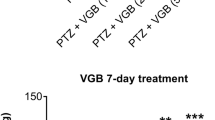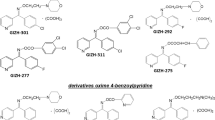Summary
Biochemical and pharmacological effects ofγ-vinyl GABA (Vigabatrin®, GVG), an irreversible enzyme-activated inhibitor of 4-aminobutyrate: 2-oxoglutarate aminotransferase (EC 2.6.1.19; GABA-T), were measured in mice. This anticonvulsant produced a time- and dose-dependent elevation of the GABA, phenylalanine and lysine contents of cortical tissue and simultaneously decreased glutamate, aspartate and alanine levels. In addition, GVG caused a biphasic change in glutamine concentrations (a decline 1–4 hours after administration, followed 20 hours later by an increase). Moreover, we found a new, as yet unidentified amino acid in the brain eluting with the same retention time as α-aminoadipic acid from an HPLC cation-exchange column. The level of this novel chemical entity was greatly increased by GVG 20 hours after injection of the drug. At all tested intervals between 1 and 60 hours after injection, GVG was ineffective against maximal electroshock. The GABA-T inhibitor dose-dependently protected mice against isoniazid-induced seizures, simultaneously causing an increase in brain GABA concentrations. However, this apparent correlation applied only until 4 hours after treatment. To better define the anticonvulsant profile of GVG, groups of mice were treated, 1, 2, 4, and 24 hours prior to challenge with convulsant doses of strychnine, pentetrazole (PTZ), and picrotoxin, and brain amino acid levels, including brain concentrations of GVG, were measured. In all instances, the time dependency of the anticonvulsant effects of GVG and of increases in brain GABA levels differed. Amino acid concentrations in animals treated only with GVG were similar to those in animals given GVG and a chemical convulsant. GVG showed no selectivity for seizures produced by impairment of GABA-ergic neurotransmission. Although GVG is an effective GABA-T inhibitor, it apparently affects several other pyridoxal-phosphate-dependent cerebral enzymes and/or interacts with other neurotransmitter systems as well.
Similar content being viewed by others
References
Benson JR, Hare PE (1975) o-Phthaldehyde: fluorogenic detection of primary amines in the picomole range. Comparison with fluorescamine and ninhydrin. Proc Natl Acad Sci USA 72: 619–622
Bernasconi R, Maitre L, Martin P, Raschdorf F (1982) The use of inhibitors of GABA-transaminase for the determination of GABA turnover in mouse brain regions: an evaluation of aminooxyacetic acid and gabaculine. J Neurochem 38: 56–66
Bernasconi R, Klein M, Martin P, Portet C, Maitre L, Jones RSG, Baltzer V, Schmutz M (1985) The specific protective effect of diazepam and valproate against isoniazid-induced seizures is not correlated with increased GABA levels. J Neural Transm 63: 169–189
Bernasconi R, Jones RSG, Bittiger H, Olpe HR, Heid J, Martin P, Klein M, Loo P, Braunwalder A, Schmutz M (1986) Does pipecolic acid interact with the central GABA-ergic system? J Neural Transm 67: 175–189
Chapman AG, Riley K, Evans MC, Meldrum BS (1982) Acute effects of sodium valproate andγ-vinyl GABA on regional amino acid metabolism in the rat brain: incorporation of 2-[14C]glucose into amino acids. Neurochem Res 7: 1089–1105
Costa E, Guidotti A, Mao CC, Suria A (1975) New concepts on the mechanism of action of benzodiazepines. Life Sci 17: 167–187
Enna SJ, Kendall DA, Browner M (1981) Differential effects ofγ-Vinyl GABA on chemically induced seizures. In: Morselli PL, Lloyd KG, Loescher W, Meldrum B, Reynolds EH (eds) Neurotransmitters, seizures and epilepsy, vol 1. Raven Press, New York, pp 107–115
Fariello RG (1985) Biochemical approaches to seizure mechanisms: the GABA and glutamate systems. In: Porter RJ, Morselli P (eds) The epilepsies. Butterworth, London, pp 1–19
Fonnum F, Fosse VM, Paulsen R (1986) The compartmentation and turnover of glutamate and GABA: a better understanding by the use of drugs. In: Boulton AA, Baker GB, Wood JD (eds) Neuromethods, vol. 3, amino acids. Humana Press, Clufton, New Jersey, pp 67–83
Gale K (1986) Role of the substantia nigra in GABA-mediated anticonvulsant action. In: Delgado-Escueta AV, Ward AA, Woodbury DM, Porter RJ (eds) Basic mechanisms of the epilepsies. Molecular and cellular approaches. Raven Press, New York (Advances in Neurology, vol 44, pp 343–364)
Gale K, Iadarola MJ (1980) Seizure protection and increased nerve terminal GABA: delayed effects of GABA transaminase inhibition. Science 208: 288–291
Iadarola MJ, Gale K (1981) Cellular compartments of GABA in brain and their relationship to anticonvulsant activity. Mol Cell Biochem 39: 305–330
Jung MJ, Lippert B, Metcalf BW, Bohlen P, Schechter PJ (1977)γ-Vinyl GABA (4-aminohex-5-enoic acid), a new selective irreversible inhibitor of GABA-T: effect on brain GABA metabolism in mice. J Neurochem 29: 797–802
Jung MJ (1982) GABA-transaminase inhibitors and neuronal function. In: Bradford HF (ed) Neurotransmitter interaction and compartmentation. Plenum Press, New York, pp 329–344
Kendall DA, Fox DA, Enna SJ (1981) Effects ofγ-Vinyl GABA on bicuculline-induced seizures. Neuropharmacology 20: 351–355
Klein M (1985) Thesis, Strasbourg
Krall RL, Penry JK, Kuperberg HJ, Swinyard EA (1978) Antiepileptic drug development. II. Anticonvulsant drug screening. Epilepsia 19: 409–428
Loiseau P, Hardenberg JP, Pestre M, Guyot M, Schechter PJ, Tell GP (1986) Doubleblind, placebo-controlled study of vigabatrin (γ-vinyl GABA) in drug-resistant epilepsy. Epilepsia 27: 115–120
Meldrum BS, Balzano E, Gadea M, Naquet R (1970) Photic and drug-induced epilepsy in the baboon (Papio papio): the effects of isoniazid, thiosemicarbazide, pyridoxine and amino-oxyacetic acid. Electroencephalogr Clin Neurophysiol 29: 333–347
Meldrum BS (1975) Epilepsy andγ-aminobutyric-acid-mediated inhibition. Int Rev Neurobiol 17: 1–35
Meldrum B, Horton R (1978) Blockade of epileptic responses in the photosensitive baboon, Papio papio, by two irreversible inhibitors of GABA-transaminase,γ-Acetylenic GABA (4-amino-hex-5-ynoic acid) andγ-Vinyl GABA (4-amino-5-enoic acid). Psychopharmacology 59: 47–50
Miller RG (1966) Simultaneous statistical inference. McGraw-Hill, New York, pp 143–153
Palfreyman MG, Schechter PJ, Buckett WR, Tell GP, Koch-Weser J (1981) The pharmacology of GABA-transaminase inhibitors. Biochem Pharmacol 30: 817–824
Perry TL, Kish SJ, Hansen S (1979)γ-Vinyl GABA: effects of chronic administration on the metabolism of GABA and other amino compounds in rat brain. J Neurochem 32: 1641–1645
Schechter PJ, Tranier Y, Jung MJ, Boehlen P (1977) Audiogenic seizure protection by elevated brain GABA concentration in mice: effects ofγ-Acetylenic GABA andγ- Vinyl GABA, two irreversible GABA-T inhibitors. Eur J Pharmacol 45: 319–328
Schechter PJ (1986) Vigabatrin. In: Meldrum BS, Porter RJ (eds) New anticonvulsant drugs. John Libbey, London, pp 265–275
Schmid R, Karobath M (1977) Specific and sensitive method for the determination ofγ- aminobutyric acid using gas chromatography with electron-capture or mass fragmentographic detection. J Chromatogr 139: 101–109
Straughan DV (1974) Convulsant drugs: amino acid antagonism and central inhibition. Neuropharmacology 13: 495–508
Ticku MK, Rastogi SK (1986) Convulsant/anticonvulsant drugs and GABAergic transmission. In: Nistico G, Morselli PL, Lloyd KG, Fariello RG, Engel J (eds) Neurotransmitters, seizures and epilepsy, vol 3. Raven Press, New York, pp 163–177
Winer BJ (1971) Statistical principles in experiment design. McGraw-Hill, New York, pp 201–204
Author information
Authors and Affiliations
Rights and permissions
About this article
Cite this article
Bernasconi, R., Klein, M., Martin, P. et al. γ-Vinyl GABA: comparison of neurochemical and anticonvulsant effects in mice. J. Neural Transmission 72, 213–233 (1988). https://doi.org/10.1007/BF01243421
Issue Date:
DOI: https://doi.org/10.1007/BF01243421




